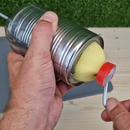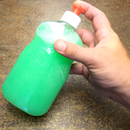Introduction: How to Make a IR Proximity Sensor at Home
In this Instructable I show you how to make a simple infrared sensor for hobby projects and to learn how an infrared sensor works.
I used an infrared sensor with one of my previous Instructables (the automatic hand sanitizer dispenser) but I didn't know exactly how this sensor worked so I dived into it a little further.
An IR sensor is basically a device which consists of a pair of an IR LED and a photodiode which are collectively called a photo-coupler or an opto-coupler. The IR LED emits IR radiation. The IR radiation is emitted in a beam from the IR LED. When this beam is disturbed, it widens and "hits" the photodiode. The photodiode converts the IR light into an electrical current. Because the output of the photodiode is not constant, I opted for a circuit with BC547 transistors. I will explain how this works in step 1.
The appendices contain a simple diagram to keep the project clear.
Supplies
- IR LED
- Photodiode
- Green LED
- 2 BC547 transistors
- 100 Ohms resistor
- 47K resistor
- 9V Battery
- 9V Battery connector
Step 1: BC 547 Transistors
A transistor is a device mostly used for switching purposes. As one of the sizable semiconductor devices, the transistor has found use in great digital applications such as embedded systems, digital circuits, and control systems. In both digital and analog domains transistors are substantially used for exceptional utility usage like amplification, logic operations, switching and so on.
In this project we use the transistors as a switch. A transistor conducts current across the collector-emitter path only when a voltage is applied to the base. When no base voltage is present, the switch is off. When base voltage is present, the switch is on. To provide the LED with sufficient voltage, we use the first transistor, which is controlled with the signal from the photodiode, to control the second transistor. This gives the LED power directly from the battery.
Solder the emitter of transistor 1 to the base of transistor 2.
Step 2: IR Led
Solder the positive connection of the IR led to the collector connection of both transistors. Cut off the other connection a bit (we need space for the resistor here).
Step 3: Resistor 100 Ohm
The IR led needs a 100 Ohm resistor. Solder this to the IR LED.
It does not matter in which direction or on which side of the IR LED. A resistor works the same in both directions.
Step 4: Green LED
Bend the pins of the LED. Solder the green LED with the + side to the emitter of transistor 2.
Step 5: Resistor 47K
Connect the 47K resistor between the - terminal of the LED and the BASE terminal of transistor 1.
Step 6: Photodiode
Now the photodiode is connected across the collector and base of transistor 1. Bend the pins of the photodiode so that it fits properly. Solder the connections.
Step 7: Finish Off
Bend the pin of the 100 Ohm resistor. Connect it with a rest piece to the negative connection of the green LED.
Step 8: Connecting the Power Supply
Fit a 9V battery connector to the sensor. The red cable to the positive connection, the black to the negative.
Step 9: Ready!
The sensor is ready! Connect a 9V battery to the connector and the sensor will work.
If the LED stays on, the IR LED or the photodiode may have to be bent slightly so that the infrared beam does not hit the photodiode (if it is not disturbed).
Have fun with this project!




